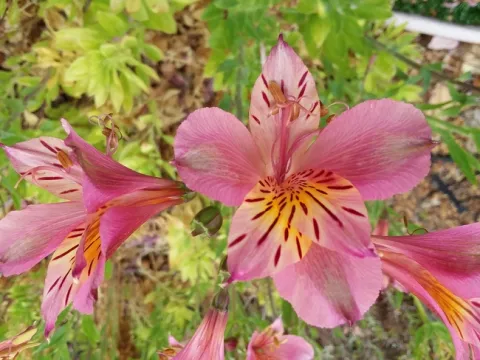
Peruvian Lily
By Polly Nelson UCCE Master Gardener
Peruvian Lily
Alstroemeria
Liliaceae
Planting Zone: Sunset 5-9, 14-24, H1; USDA 7-11
Size: Two varieties, one with leafy stems 2-3 feet, another (dwarf) with mounding, shorter leafy stems up to one foot.
Bloom season: Late Spring into fall
Exposure: Full sun to partial shade in hottest climates
Pruning needs: Clear out fallen foliage and remove dead stems and flowers regularly to promote blossoms.
Water needs: Moderate during growth and bloom; none needed during dormancy
Narrative: Colorful, easy to grow, low maintenance and faithful re-bloomers, Alstroemeria are perennials that flourish massed in flower beds or grown in containers. The dramatic blooms range from white and yellow to red and purple, with many shades in-between. Multiple 6-petal blossoms with contrasting flecks and stripes sit atop green, sword-shaped alternating leaves. The stems grow vertically from horizontal rhizomes. Cut flowers last up to two weeks indoors; longer if not cut. When removing blossoms or deadheading, do not cut the stem. Instead, gently twist the stem from the base of the plant and pull. This will prompt the plant to produce more blossoms over several months.
While Alstroemeria can be grown from seeds, the easiest way to propagate this plant is by dividing the rhizomes into small clusters (minimum 4-5 rhizomes, including roots). Cut foliage back to 6-8 inches 1-2 weeks before dividing, then plant the clusters in well-draining soil. Plant in the ground 12-18 inches apart; in pots, plant 6 inches deep. Use two to three inches of compost or shredded bark around the clusters to enrich the soil, keep the roots cool, and extend the blooming period. Water well when first planted. Once established, water needs will decrease. Water moderately. Don't let the soil dry out or become over-saturated. Fertilize in early spring with a high-nitrogen (12-4-8) time-release or water-soluble fertilizer following label instructions.
Of note: when planted in the ground, Alstroemeria will self-seed, expand and potentially crowd the roots of nearby plants over time. Also, snails and slugs are attracted to Alstroemeria so monitor to prevent damage from these visitors.

